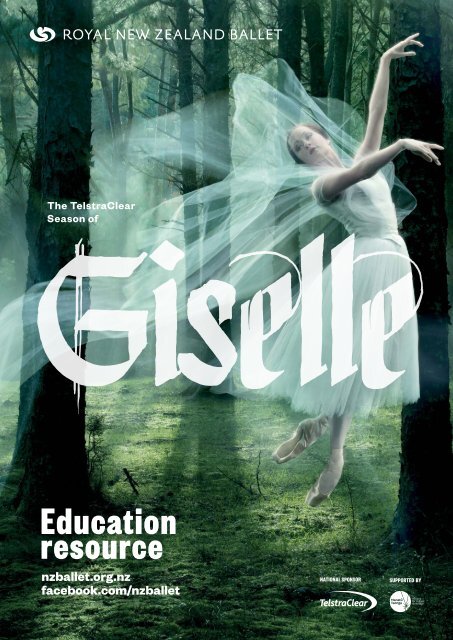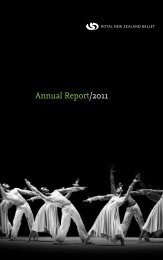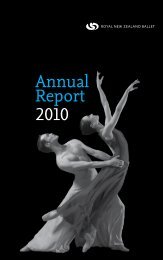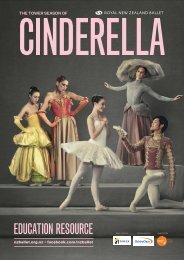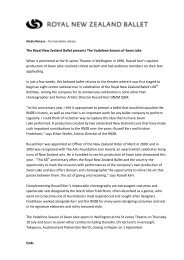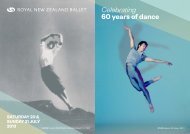Education resource - Royal New Zealand Ballet
Education resource - Royal New Zealand Ballet
Education resource - Royal New Zealand Ballet
Create successful ePaper yourself
Turn your PDF publications into a flip-book with our unique Google optimized e-Paper software.
The TelstraClear<br />
Season of<br />
<strong>Education</strong><br />
<strong>resource</strong><br />
nzballet.org.nz<br />
facebook.com/nzballet<br />
NATIONAL SPONSOR<br />
SUPPORTED BY
Learning outcomes<br />
In this unit you and your students will:<br />
• Learn about the elements that come together to<br />
create a theatrical ballet experience.<br />
• Identify the processes involved in making a<br />
theatre production happen.<br />
• Learn about the traditional elements of the<br />
Giselle story and the development of the<br />
RNZB’s version.<br />
Curriculum Links in this unit<br />
Values<br />
Students will be encouraged to value:<br />
• Innovation, inquiry and curiosity, by thinking<br />
critically, creatively and reflectively.<br />
• Diversity, as found in our different cultures and<br />
heritages.<br />
• Community and participation for the<br />
common good.<br />
Key Competencies<br />
• Using language, symbols and text –<br />
Students will recognise how choices of<br />
language and symbols in live theatre affect<br />
people’s understanding and the ways in which<br />
they respond.<br />
• Relating to others – Students will develop<br />
the ability to listen actively and share ideas<br />
regarding theatrical ballet performances.<br />
• Participating and contributing – students<br />
will be actively involved in their cultural<br />
community, understanding the importance of<br />
creative environments.<br />
• Thinking – Students will reflect on their<br />
own thinking and learning after the personal<br />
experience of attending a live theatre show.<br />
Workshop Achievement<br />
Objectives<br />
The Arts Level 3 and 4: Dance<br />
• Developing Practical Knowledge – Students<br />
will apply the dance elements from the RNZB’s<br />
Giselle to extend personal movement skills and<br />
vocabularies and to explore the vocabularies of<br />
others.<br />
• Developing Ideas – Students will combine and<br />
contrast the dance elements to express images,<br />
ideas and feelings from Giselle using variety of<br />
choreographic processes.<br />
• Communicating and Interpreting – Describe<br />
how the purpose of dance is expressed through<br />
movement.<br />
• Understanding the Arts in Context –<br />
students will explore and describe how dance<br />
is used for different purposed in a variety of<br />
contexts.<br />
2
Giselle synopsis<br />
The story unfolds at harvest time in a remote<br />
village, as the beautiful and innocent Giselle is<br />
courted by a mysterious young man. Giselle, the<br />
only daughter of a widowed mother, loves to dance<br />
and play and, despite her mother’s misgivings, is<br />
uninterested in the local gamekeeper, Hilarion, and<br />
captivated by the dashing young stranger. When<br />
he is revealed, publicly and painfully, as Count<br />
Albrecht, Giselle loses her reason and falls dead.<br />
In a moonlit forest grove, the Wilis, unquiet spirits<br />
of girls betrayed in love, meet to welcome their new<br />
sister. Giselle rises from her grave, more beautiful<br />
than ever but destined to haunt the twilight,<br />
seeking revenge on all men. Hilarion arrives to<br />
mourn at Giselle’s graveside. Seized by the Wilis,<br />
he is forced to dance until he drops dead. When<br />
Albrecht comes, bearing lilies for his dead love,<br />
he is destined to meet the same fate at the hands<br />
of the merciless Wilis, until Giselle’s gentle spirit,<br />
loving and faithful even in death, shields him from<br />
their fury.<br />
3
Historical note<br />
First staged in Paris in 1841, Giselle as a ballet<br />
scenario was developed by the poet and novelist<br />
Théophile Gaultier (1811–1872). Giselle is one of<br />
the oldest surviving ballets still performed.<br />
Gautier was inspired by a passage from Heinrich<br />
Heine’s 1835 work, De l’Allemagne. When he<br />
discovered the passage he wrote enthusiastically<br />
to Heine:<br />
My dear Henri Heine,<br />
While leafing through your beautiful book,<br />
De l’Allemagne, a few weeks ago, I came<br />
across a charming passage (one has<br />
merely to open the volume at random).<br />
It was the passage in which you speak<br />
of sprites in white gowns with hems that<br />
are perpetually damp, fairies whose little<br />
satin feet mark the ceiling of the nuptial<br />
chamber, the snow-white Wilis who<br />
waltz pitilessly the whole night long, and<br />
wondrous apparitions encountered in the<br />
Hartz mountains and on the banks of the<br />
Ilse, glimpsed in a mist bathed by German<br />
moonlight - and I said out loud, “What a<br />
pretty ballet one could make of that!<br />
Opéra, my head still full of your ideas, I<br />
met at the turning of a corridor the man<br />
of wit [Saint-Georges] who, by adding<br />
so much of his own, knew just how to<br />
infuse a ballet with all the fantasy and<br />
all the caprice of Le Diable Amoureux<br />
by Cazotte, the great poet who invented<br />
Hoffmann in the middle of the eighteenth<br />
century, according to the complete<br />
Encyclopedia. I told him the legend of the<br />
wilis. Three days later, the ballet Giselle<br />
was finished and accepted. At the end of<br />
the week, Adolphe Adam had composed<br />
the music, the scenery was nearly<br />
completed, and rehearsals went into full<br />
swing….”<br />
Letter from www.balletmet.org<br />
“In a rush of enthusiasm, I even took<br />
a large, lovely sheet of white paper<br />
and wrote at the top, in superbly clear<br />
script: LES WILIS, ballet. Then I burst<br />
out laughing and threw the paper away<br />
without going any further, telling myself<br />
that it was certainly impossible to translate<br />
all of that into theatrical terms - that misty<br />
nocturnal poetry, that voluptuously sinister<br />
phantom world, all those effects of legend<br />
and ballad that have so little in common<br />
with our customs. That evening at the<br />
4
Themes of Giselle<br />
Romantic Movement<br />
Giselle is known as one of the most quintessential<br />
romantic ballets, representing the themes and<br />
ideals of the Romantic Movement. The <strong>Royal</strong> <strong>New</strong><br />
<strong>Zealand</strong> <strong>Ballet</strong> production is set in mid-Victorian<br />
times, when interest in all things ghostly was<br />
popular. The story of Giselle is both romantic and<br />
ghostly, a perfect fit for this era.<br />
Vulnerability<br />
Both of the main characters have a sense of<br />
vulnerability at some point in the story. Giselle<br />
becomes weak when the truth is shown, and her<br />
character is physically venerable with a frail heart.<br />
Albrecht becomes weak with grief as he mourns<br />
Giselle’s death and they both show a vulnerable<br />
side as they fall in love in act one.<br />
Madness and Death<br />
Giselle is often called “the Hamlet of dance”, due<br />
partly to its themes of madness and death, and<br />
also because of the difficulties of the lead role.<br />
Depending on which production you see, Giselle<br />
either dies of a frail broken heart or she takes her<br />
own life with a dagger. In both scenarios she is so<br />
overcome with grief that she is taken by madness.<br />
Portraying the spirit world<br />
When Giselle was first performed dancing en<br />
pointe had just become popular. Giselle brought<br />
it to prominence as this new style of dancing<br />
was perfectly suited to the ghostly wilis, who<br />
appear in this romantic ballet. Pointe work allowed<br />
ballerinas to create the illusion of floating like a<br />
ghost and to balance as if poised to take flight.<br />
The choreography uses a lot of soft rounded arm<br />
movements which have fairy like qualities adding to<br />
the ghostly interpretation of the wilis.<br />
5
A different point of view<br />
The story of Giselle is seen through the eyes of<br />
the main character Giselle. But how do the other<br />
characters feel about the situation? What about<br />
Giselle’s mum? Does Hilarion think about the<br />
consequences of his actions?<br />
Rewrite the story of Giselle from one of<br />
these characters point of view.<br />
• Albrecht<br />
• Hilarion<br />
• Bathilde (Albrecht’s fiancée)<br />
• Queen Myrtha<br />
• The other Wilis<br />
6
Story line<br />
What is the story of Giselle about?<br />
Is there a moral to the story? What is it?<br />
What is the climax of the story of Giselle?<br />
How would you change the story to make it<br />
more “modern”?<br />
How is the story resolved?<br />
7
There’s a time and place<br />
Time<br />
In which period do you think Giselle is set?<br />
What makes you think this?<br />
Place<br />
Where is Giselle the story set? Is it a town?<br />
City? <strong>New</strong> <strong>Zealand</strong>?<br />
Do you think the same story could be set in<br />
present day? Why?<br />
How do you know?<br />
Do you think the character of Giselle would<br />
act the same? Why?<br />
How would the story change if it were set in<br />
your neighbourhood?<br />
What changes would need to be made if it<br />
were set in 2012?<br />
8
RNZB costumes<br />
Our costumes have been designed by Natalia<br />
Stewart. She started her career as a classical<br />
ballet dancer after graduating from Moscow<br />
Choreographic Academy (Bolshoi Academy).<br />
After moving to the UK Natalia continued to dance<br />
but at the same time started to pursue her interest<br />
in theatre design. Throughout her dancing career<br />
she met inspirational artists who help to learn the<br />
basics of the design and develop her own style.<br />
In 2001 Natalia successfully graduated from<br />
London College of Fashion with BA in Theatre and<br />
Costume design.<br />
She has since worked for many of London’s West<br />
end Theatres and at the <strong>Royal</strong> Opera House.<br />
Natalia has designed the <strong>Royal</strong> <strong>New</strong> <strong>Zealand</strong><br />
<strong>Ballet</strong>’s Giselle costumes using historical<br />
references from the mid-Victorian era.<br />
Many characters’ costumes have a military theme,<br />
and a sense of aristocracy and wealth.<br />
The Wilis are in longer tutus, which represent the<br />
Victorian fashion of longer, fuller dresses. They are<br />
cut to just above the ankle so the audience can<br />
see the feet dancing.<br />
Every costume needs to be made multiple times for<br />
the different dancers performing each role. Each<br />
dancer has to be individually measured and fitted<br />
for each costume. Each dancer will have at least<br />
two roles they will be performing, which makes for<br />
a lot of costumes and a lot of work! The wardrobe<br />
department more than doubles in the weeks before<br />
a big production to ensure all of the measuring,<br />
fitting and sewing gets done on time.<br />
RNZB wardrobe<br />
Department and<br />
Giselle costumes<br />
in production<br />
9
Giselle costume sketches<br />
Giselle Act 1<br />
costume sketch<br />
Giselle Act 2<br />
costume sketch<br />
Albrecht<br />
costume<br />
sketch<br />
Hilarion<br />
costume<br />
sketch<br />
Bathilde<br />
costume<br />
sketch<br />
Giselle and<br />
albrecht act 1<br />
costume sketch<br />
10
Now it’s your turn!<br />
Choose two characters from Giselle that you<br />
would like to design a costume for.<br />
Choose from:<br />
Giselle – a young and beautiful peasant girl<br />
What outfit would you design for these<br />
characters?<br />
Remember they need to dance freely and<br />
show off their performance!<br />
Count Albrecht – a young nobleman who<br />
disguises himself as a peasant<br />
Hilarion – a local forester<br />
Myrtha – Queen of the Wilis<br />
Berthe – Giselle’s mother<br />
Countess Bathilde – a young woman of noble<br />
birth, Albrecht’s fiancée<br />
Duke of Courland – Bathilde’s father<br />
Wilfred – Albrecht’s servant<br />
Also: peasants, a hunting party, the Wilis<br />
11
Character one<br />
12
Character two<br />
13
Giselle stage design<br />
For every show the <strong>Royal</strong> <strong>New</strong> <strong>Zealand</strong> <strong>Ballet</strong><br />
presents, there are many, many people involved,<br />
not just the dancers.<br />
One busy group of people is the Production Team<br />
who design and build the set then “bump in” (that<br />
means put it on stage) the set in each theatre.<br />
The production team is given a mini model of the<br />
stage by the designer. It’s a tiny version of what the<br />
stage will eventually look like. Often the designer<br />
and the Technical Director spend days fiddling with<br />
the details of the mini stage, they even have mini<br />
props and mini cut out dancers!<br />
Here are some images of the Giselle stage design<br />
in miniature.<br />
14
Make your own theatre model box<br />
1 Use an old cardboard box such as a shoe box<br />
or a photo copy paper box.<br />
4 Cut 3cm wide lengths of card that are<br />
LONGER than your stage box.<br />
2 Draw your three layers of back drop on A4<br />
paper or card.They should fit snugly into the box<br />
so you may need to cut the paper accordingly.<br />
Remember to keep the middle blank for the<br />
performers.<br />
5 Attach the 3cm wide strips to the top of each<br />
backdrop picture.<br />
We used:<br />
• Back layer – Hills<br />
• Middle layer – Thick trees<br />
• Front layer – Bushy Trees<br />
But you can do anything! For example:<br />
• Castles with different levels<br />
• Sky with clouds<br />
• Village with many houses<br />
• Busy street with sky scrapers<br />
3 Cut out the inside of your backdrop pictures.<br />
6 Cut three 3cm slots on each side of the box.<br />
These should be parallel and evenly spaced.<br />
7 Place the three back drops into the parallel<br />
slots.<br />
15
8 Add scenery such as a house, individual tree,<br />
furniture, lamp posts etc.<br />
10 You can get really adventurous with:<br />
• Trap doors<br />
• Different materials (e.g. lace, cobwebbing,<br />
glittery fabric)<br />
• Lighting<br />
• Special effects<br />
9 Finally add your cut out performers and any<br />
other small props you need to tell your story.<br />
16
Giselle mime<br />
Death<br />
Hands overhead, fists crossed at wrists…<br />
Marriage or engagement<br />
Right hand indicates left ring on finger<br />
...come down in front of body to waist level.<br />
A strong motion!<br />
Promise/Vow/Swear<br />
Two fingers raised overhead<br />
Love<br />
One or two hands on heart<br />
17
Giselle dance evaluation<br />
Once you have viewed the <strong>Royal</strong> <strong>New</strong> <strong>Zealand</strong><br />
<strong>Ballet</strong>’s Giselle use the following to help you<br />
evaluate the performance.<br />
Pathways<br />
• What pathways were used?<br />
• Did the pathways work with or against each<br />
other?<br />
Levels<br />
Using different levels in a dance piece is very<br />
important to create variety.<br />
• What levels were used in Giselle?<br />
• Did a character/dance have a “signature level”?<br />
• Why would the choreographer do this?<br />
18
Dynamics<br />
• How did the dancers portray their character?<br />
• Which character did you like the best? Why?<br />
• How would you portray a character differently?<br />
Groups or formations<br />
• Group formations are used a great deal in<br />
Giselle. Why?<br />
• What do the formations tell the audience about<br />
the characters?<br />
Shapes<br />
What shapes did the dancers make with:<br />
• Their bodies?<br />
• Each other?<br />
• What parts of their bodies did they use?<br />
• How did they use symmetry?<br />
19
Giselle audience evaluation<br />
Once you have viewed the <strong>Royal</strong> <strong>New</strong> <strong>Zealand</strong><br />
<strong>Ballet</strong>’s performance of Giselle use the following to<br />
help you evaluate the performance<br />
The bit I enjoyed most was<br />
Because:<br />
I would have improved the<br />
scene by<br />
20
My favourite character was<br />
Because<br />
The character I least liked was<br />
Because<br />
21


